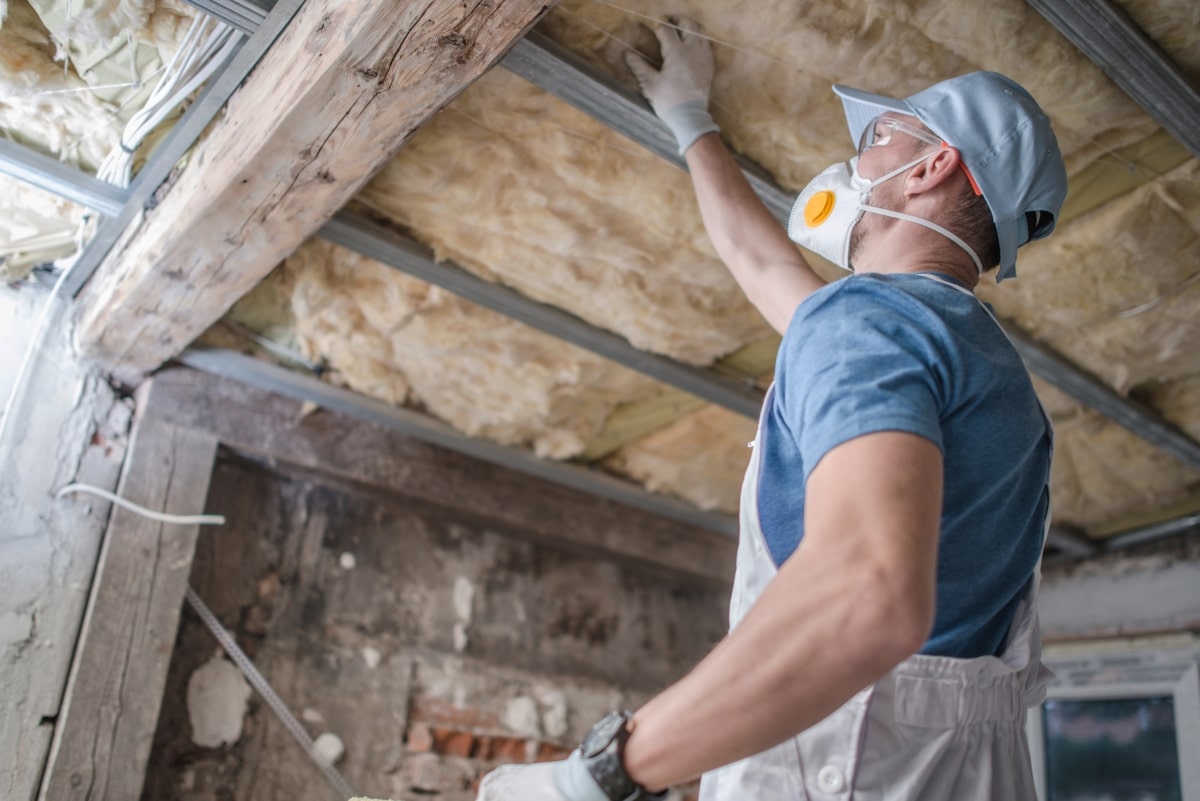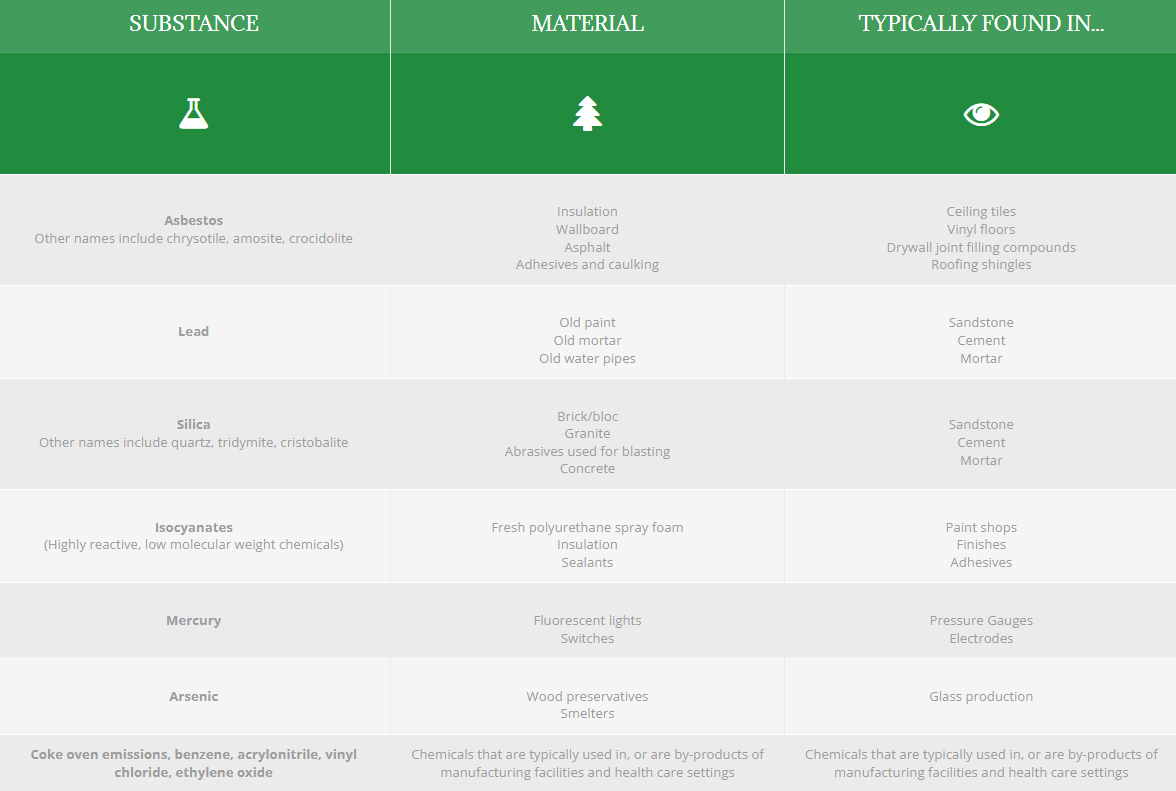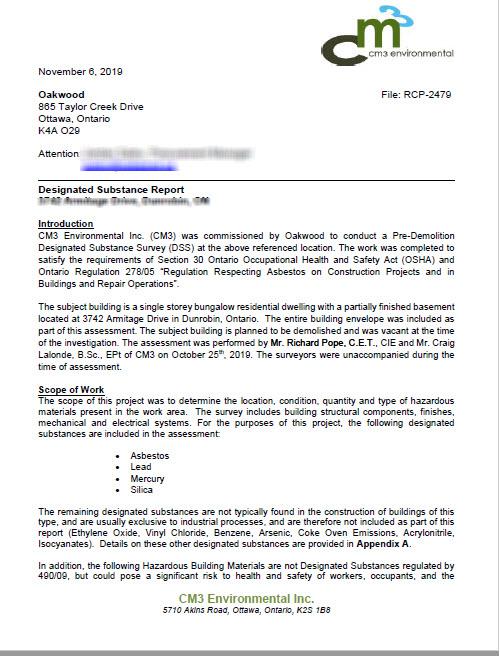Designated Hazardous Substances:
What you must do to protect workers, yourself and family members from harmful materials


In Ontario, it’s your responsibility as the homeowner to identify substances designated by the province as hazardous. This list must be provided to potential contractors before they begin work or contracts are finalized.
Many homeowners wrongly think it’s the contractor’s responsibility to identify anything harmful before starting any work in their home. Or that hazardous materials only apply to big renovations or commercial projects.
Both assumptions are wrong and can land you in hot water. In fact, we’re seeing the province paying much more attention to residential projects, particularly projects involving older homes. Homeowners risk receiving stop-work orders from the Ministry of Labor and big fines for failing to properly identify designated substances.
What substances are identified? What projects does this Act apply to? Here’s what you need to know.
Occupational Health and Safety Act
The reality is, when you engage any outside contractors, your home becomes a work site. As such, it is subject to all laws designed to ensure the health and safety of workers.
Specifically, under section 30 of the Occupational Health and Safety Act, the Province of Ontario requires a project owner to provide a list of all designated substances if they are present on a construction site.
You may be thinking that wouldn’t apply to something as simple as the installation of a ceiling fan. Not so, if your home was built before 1984. Chances are good that asbestos lurks in some construction materials, including your ceiling. Technically, it’s your responsibility to alert a contractor to that possibility. Yet few homeowners do. Why?
Unaware or ignored
In our experience, most have never heard of the Designated Substances Act. Homeowners count on their contractor to inform them of any suspected hazardous materials. This is exactly the opposite of what they should do.
And many smaller contractors who may know about the Act, don’t mention anything for one simple reason – raising the possibility that there are harmful substances and they will need to pay to have them professionally removed, could cause the homeowner to turn to someone else.
So rather than risk losing the business, many smaller contractors simply turn a blind eye and only flag something if there’s a glaring health issue. Which may not be the case for something small: like installing an overhead fan on a popcorn ceiling even if they did suspect asbestos. Unless the ceiling was in serious disrepair from water damage and the possibility of asbestos fibers becoming air borne was high, most would consider the risks low.
The Designated Substances Lists
There are 11 substances identified on the Designated Substances List. These can cause cancers, strong allergic reactions, lung problems, effects on the nervous system. Even death can occur with enough exposure to some of these toxic substances.
So exactly what’s on the list and where can you expect to find them in your home?


Substances of most concern
Although all the substances on the above list are toxic; asbestos, silica, lead, and mercury are the most prevalent in a residential setting. Of these, asbestos is at the top of OakWood’s list for substances we are most concerned about. In part, that’s because it’s the most common and the regulations for identifying and removing this material are very specific.
Some domestic pipe systems on older homes use solder on joints, and lead-based paints. Mercury can be found as a preservative in some older paints and thermostats which have mercury tubes.
Coke oven emissions and various oxides are also on the list, but they are strictly related to industrial processes and relevant only to commercial buildings.
Asbestos widely used until 1980
From 1930 to 1990 there was extensive use of asbestos in home-building materials in Canada. It can be found in over 3,000 construction materials including joint compounds, spray products such as “popcorn” ceilings, floor tiles, pipe cement, heating pipe insulation wrap, roofing tiles, and many others.
All that ended in 1980 when asbestos was designated a hazardous substance and removed from new construction materials. However, it took many years to get everything with asbestos out of circulation.
That’s why OakWood automatically tests for asbestos if the home was built before 1984. Although it is the homeowner’s responsibility to check for hazardous substances before a project begins, OakWood makes this investment when we suspect asbestos given the age of a home.
This is especially true if the project involves gutting a room to the studs or tearing down a significant portion of the house. This level of demolition generates considerable dust, which not only exposes workers and family members to potential asbestos fibers, but the entire neighborhood.
Only a risk if disturbed
It’s important to note that experts agree that asbestos doesn’t pose a health risk if it is left covered and undisturbed. For example, a popcorn ceiling or drywall may have asbestos, but invariably this is primed and then covered with two or three coats of paint. This effectively seals-in the asbestos rendering it harmless.
Designated Substances Report


A comprehensive, 26-page environmental assessment for asbestos, lead, mercury, and silica
While identifying designated substances is not normally time consuming, it does require specialized expertise. For that reason, OakWood outsources assessments to independent companies like CM3, an Ottawa based company that provides high-quality environmental assessment services for both residential and commercial projects.
While you can get an assessment done yourself, if you suspect the presence of hazardous substances, OakWood includes this optional step as part of a seamless, end to end Design & Build solution.
Our clients get a concise report, usually within 5 to 7 days, identifying any hazardous substances with recommended solutions for removal.
Removal of substances
What happens if an assessment confirms hazardous materials?
Again, the province is very specific about substances that must be removed. In most cases this requires the services of an environmental abatement contractor – someone who is licensed, trained, and insured in the removal of designated hazardous substances.





